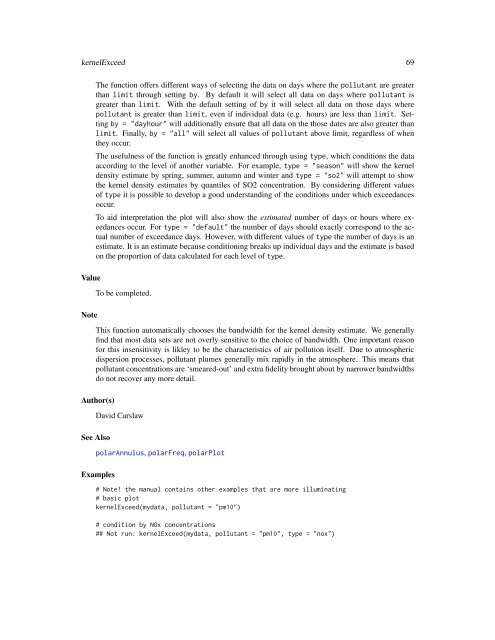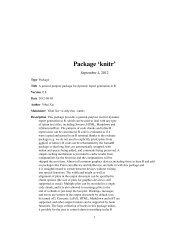Package 'openair'
Package 'openair'
Package 'openair'
Create successful ePaper yourself
Turn your PDF publications into a flip-book with our unique Google optimized e-Paper software.
kernelExceed 69ValueNoteThe function offers different ways of selecting the data on days where the pollutant are greaterthan limit through setting by. By default it will select all data on days where pollutant isgreater than limit. With the default setting of by it will select all data on those days wherepollutant is greater than limit, even if individual data (e.g. hours) are less than limit. Settingby = "dayhour" will additionally ensure that all data on the those dates are also greater thanlimit. Finally, by = "all" will select all values of pollutant above limit, regardless of whenthey occur.The usefulness of the function is greatly enhanced through using type, which conditions the dataaccording to the level of another variable. For example, type = "season" will show the kerneldensity estimate by spring, summer, autumn and winter and type = "so2" will attempt to showthe kernel density estimates by quantiles of SO2 concentration. By considering different valuesof type it is possible to develop a good understanding of the conditions under which exceedancesoccur.To aid interpretation the plot will also show the estimated number of days or hours where exeedancesoccur. For type = "default" the number of days should exactly correspond to the actualnumber of exceedance days. However, with different values of type the number of days is anestimate. It is an estimate because conditioning breaks up individual days and the estimate is basedon the proportion of data calculated for each level of type.To be completed.This function automatically chooses the bandwidth for the kernel density estimate. We generallyfind that most data sets are not overly sensitive to the choice of bandwidth. One important reasonfor this insensitivity is likley to be the characteristics of air pollution itself. Due to atmosphericdispersion processes, pollutant plumes generally mix rapidly in the atmosphere. This means thatpollutant concentrations are ‘smeared-out’ and extra fidelity brought about by narrower bandwidthsdo not recover any more detail.Author(s)See AlsoDavid CarslawpolarAnnulus, polarFreq, polarPlotExamples# Note! the manual contains other examples that are more illuminating# basic plotkernelExceed(mydata, pollutant = "pm10")# condition by NOx concentrations## Not run: kernelExceed(mydata, pollutant = "pm10", type = "nox")
















